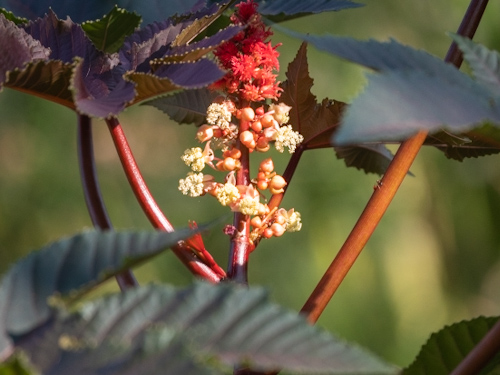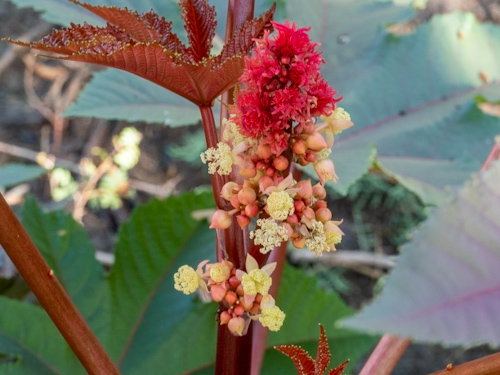
Common Names: Castor Bean Plant, Castor Oil Plant
Synonyms: Ricinus communis
Family: Euphorbiaceae (Spurge)
Habit: per shrub/tree
Size: up to 39 feet (12 m)
Flowers: Male: Yellow, White Female: Red
Bloom: Jun, Jul, Aug, Sept
Leaves: alternate
Fruit: 1/2” long seeds
Description:
Castor bean is a tropical plant that won’t survive in temperatures below 32 degrees F. In cooler climates, it is therefore grown as an annual that concludes its life cycle with the first frost. It tolerates high humidity well.
The alternate, star-shaped leaves on long petioles can grow over 2½ feet across. Each palmate leaf has 5 to11 deeply incised lobes, with serrated edges and prominent central veins.
The flowers lack petals and are unisexual (male and female) where both types are borne on the same plant (monoecious) in terminal panicle-like inflorescences of green or, in some varieties, shades of red. The male flowers are numerous, yellowish-green with prominent creamy stamens; the female flowers, borne at the tips of the spikes, lie within the immature spiny capsules, are relatively few in number and have prominent red stigmas.
The seed pods may be green, pink, or red (depending on the variety), but gradually age to brown. Each spherical, seed capsule is thickly covered with soft flexible spines and has three sections that separate when the seeds are mature. Each section contains one seed that is ejected, often with considerable force, when the carpel splits open. Castor seeds have a warty appendage called the caruncle, which is a type of elaiosome. The caruncle promotes the dispersal of the seed by ants (myrmecochory).
Ricin is a poison found naturally in castor beans. If castor beans are chewed and swallowed, the released ricin can cause injury or death.
Distribution: Castor is indigenous to the southeastern Mediterranean Basin, Eastern Africa, and India, but is widespread throughout tropical regions (and widely grown elsewhere as an ornamental plant).
Seen:
Habitat:







